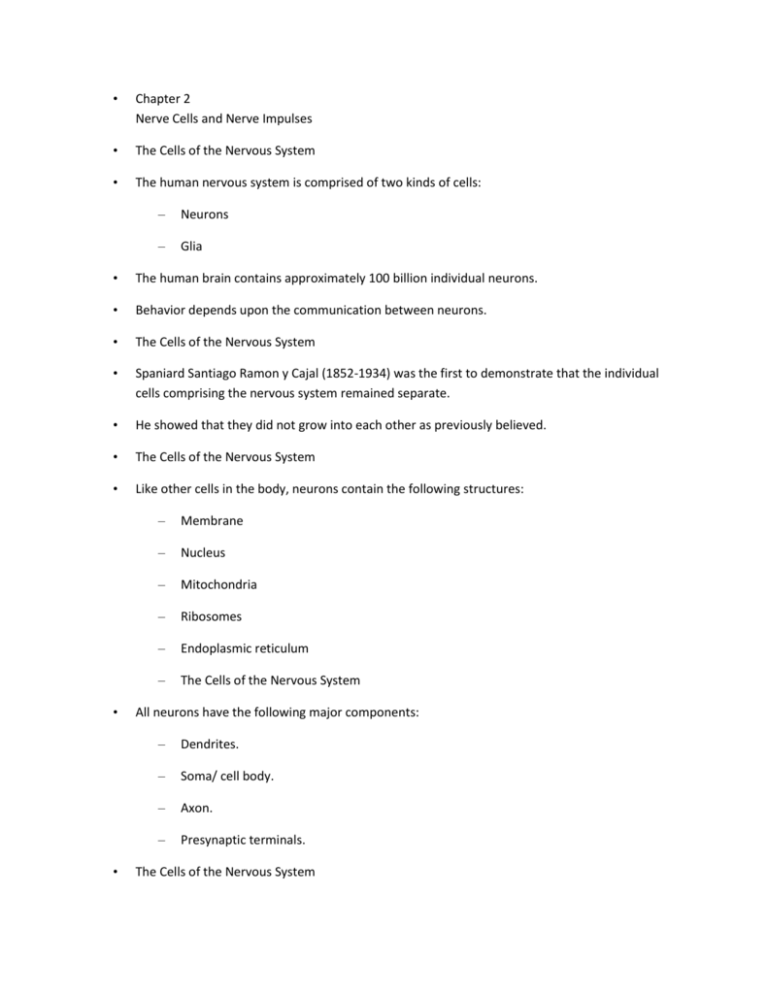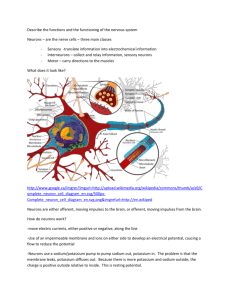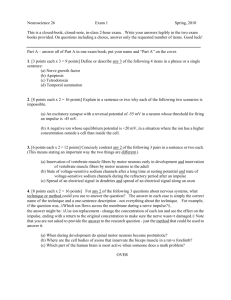Chapter 2 Nerve Cells and Nerve Impulses • The Cells of the
advertisement

• Chapter 2 Nerve Cells and Nerve Impulses • The Cells of the Nervous System • The human nervous system is comprised of two kinds of cells: – Neurons – Glia • The human brain contains approximately 100 billion individual neurons. • Behavior depends upon the communication between neurons. • The Cells of the Nervous System • Spaniard Santiago Ramon y Cajal (1852-1934) was the first to demonstrate that the individual cells comprising the nervous system remained separate. • He showed that they did not grow into each other as previously believed. • The Cells of the Nervous System • Like other cells in the body, neurons contain the following structures: • • – Membrane – Nucleus – Mitochondria – Ribosomes – Endoplasmic reticulum – The Cells of the Nervous System All neurons have the following major components: – Dendrites. – Soma/ cell body. – Axon. – Presynaptic terminals. The Cells of the Nervous System • Dendrites- branching fibers with a surface lined with synaptic receptors responsible for bringing in information from other neurons. • Some dendrites also contain dendritic spines that further branch out and increase the surface area of the dendrite (see sensory neuron on p. 31 of text) • The Cells of the Nervous System • Soma - contains the nucleus, mitochondria, ribosomes, and other structures found in other cells. – Also responsible for the metabolic work of the neuron. (see picture on p. 29 of text) • The Cells of the Nervous System • Axon - thin fiber of a neuron responsible for transmiting nerve impulses away to other neurons, glands, or muscles. • Some neurons are covered with an insulating material called the myelin sheath with interruptions in the sheath known as nodes of Ranvier. (see picture of motor neuron on p.30 of text) • The Cells of the Nervous System • Presynaptic terminals or axon terminals (aka Terminal buttons) refer to the end points of an axon responsible for releasing chemicals to communicate with other neurons. (see p. 30 of text) • The Cells of the Nervous System Neuron types • Neurons vary in size, shape, and function. • The shape of a neuron determines it connection with other neurons and its connections with other neurons. • The function is closely related to the shape of a neuron. – Example: Pukinje cells of the cerebellum branch extremely widely within a single plane • The Cells of the Nervous System Blood Brain Barrier • The blood-brain barrier is a mechanism that surrounds the brain and blocks most chemicals from entering. • The immune system destroys damaged or infected cells throughout the body. • Because neurons in the brain generally do not regenerate, it is vitally important for the blood brain barrier to block incoming viruses, bacteria or other harmful material from entering. • The Cells of the Nervous System Blood Brain Barrier • Active transport is the protein mediated process by which useful chemicals are brought into the brain. • Glucose, hormones, amino acids, and vitamins are brought into the brain via active transport. • Glucose is a simple sugar that is the primary source of nutrition for neurons. – Thiamine is a chemical that is necessary for the use of glucose. • The Nerve Impulse • A nerve impulse is the electrical message that is transmitted down the axon of a neuron. • The impulse does not travel directly down the axon but is regenerated at points along the axon. • The speed of nerve impulses ranges from approximately 1 m/s to 100 m/s. • The Nerve Impulse Resting Potential • The resting potential of a neuron refers to the state of the neuron prior to the sending of a nerve impulse. • The membrane of a neuron maintains an electrical gradient which is a difference in the electrical charge inside and outside of the cell. • The Nerve Impulse Resting Potential • At rest, the membrane maintains an electrical polarization or a difference in the electrical charge of two locations. – the inside of the membrane is slightly negative with respect to the outside. (approximately -70 millivolts) • The Nerve Impulse Membrane and Chemical Ions • The membrane is selectively permeable, allowing some chemicals to pass more freely than others. • Potassium (+) and Protein (-) inside • Sodium (+) and Chloride (-) outside • Sodium, potassium, calcium, and chloride pass through channels in the membrane. • When the membrane is at rest: – Sodium channels are closed. – Potassium channels are partially closed allowing the slow passage of sodium. • Potassium (+) and Protein (-) inside • Sodium (+) and Chloride (-) outside • The Nerve Impulse Membrane and sodium-potassium pump • Two physical pressures work on the membrane that the membrane works to resist – Electrostatic pressure – Concentration gradient • Protein is too large to exit the cell • The electrical gradient and the concentration gradient work to pull sodium ions into the cell. • The electrical gradient tends to pull potassium ions into the cells, and keep chlorine ions out of the cell • The Nerve Impulse Membrane Potential There are two forces acting on the membrane when the neuron is at rest • Electrostatic pressure – the inside of the neuron is negatively charged as opposed to the outside causing pressure to bring that to zero • Concentration gradient – There are more potassium and protein ions inside, and more sodium and chloride ions outside, causing pressure for the ions to go from the high to the low concentration area. • The Nerve Impulse Postsynaptic Potential and Threshold • The resting potential remains stable until the neuron is stimulated. • Hyperpolarization refers to increasing the polarization or the difference between the electrical charge of two places. • Depolarization refers to decreasing the polarization towards zero. • The threshold of excitement refers any stimulation beyond a certain level and results in a massive depolarization. • The Nerve Impulse Action Potential • An action potential is a rapid depolarization of the neuron. • Stimulation of the neuron past the threshold of excitation triggers a nerve impulse or action potential. • The Nerve Impulse Action Potential • Voltage-activated channels are membrane channels whose permeabililty depends upon the voltage difference across the membrane. – Sodium channels are voltage activated channels. • When sodium channels are opened, positively charged sodium ions rush in and a subsequent nerve impulse occurs. • The Nerve Impulse Action Potential • After an action potential occurs, sodium channels are quickly closed. • The neuron is returned to its resting state by the opening of potassium channels. – potassium ions flow out due to the concentration gradient and take with them their positive charge. • The sodium-potassium pump later restores the original distribution of ions. • The Nerve Impulse Effect of drugs • Local anesthetic drugs block sodium channels and therefore prevent action potentials from occurring. – Example: Novocain • The Nerve Impulse Action Potential • The all-or-none law states that the amplitude and velocity of an action potential are independent of the intensity of the stimulus that initiated it. – Action potentials are equal in intensity and speed within a given neuron. – Action potentials either happen or do not happen • The Nerve Impulse Refractory period • After an action potential, a neuron has a refractory period during which time the neuron resists another action potential. • The absolute refractory period is the first part of the period in which the membrane can not produce an action potential. • The relative refractory period is the second part in which it take a stronger than usual stimulus to trigger an action potential. • The Nerve Impulse Action potential • In a motor neuron, the action potential begins at the axon hillock (a swelling where the axon exits the soma). • Propagation of the action potential is the term used to describe the transmission of the action potential down the axon. – the action potential does not directly travel down the axon. • The Nerve Impulse Saltatory conduction • The myelin sheath of axons are interrupted by short unmyelinated sections called nodes of Ranvier. • At each node of Ranvier, the action potential is regenerated by a chain of positively charged ion pushed along by the previous segment. • The Nerve Impulse Saltatory conduction • Saltatory conduction is the word used to describe this “jumping” of the action potential from node to node. • – Provides rapid conduction of impulses – Conserves energy for the cell Multiple sclerosis is disease in which the myelin sheath is destroyed and associated with poor muscle coordination. • The Nerve Impulse Postsynaptic potentials • Not all neurons have lengthy axons. • Local neurons have short axons, exchange information with only close neighbors, and do not produce action potentials. • When stimulated, local neurons produce graded potentials which are membrane potentials that vary in magnitude and do not follow the all-or-none law,. • A local neuron depolarizes or hyperpolarizes in proportion to the stimulation. • Differences between types of potential • Action Potential • – Causes the neuron’s charge to go from threshold to +30 mV – Is an all or none event – Is actively generated – Happens when the neuron reaches threshold at the axon hillock – Causes neurotransmitter vesicles to fuse with the terminals and release chemicals into the synapse Postsynaptic potential – Can be either excitatory or inhibitory – Is a graded potential – Travels passively – Happens in response to different neurotransmitters attaching to the receptors – Makes the neuron more or less likely to “fire.”








